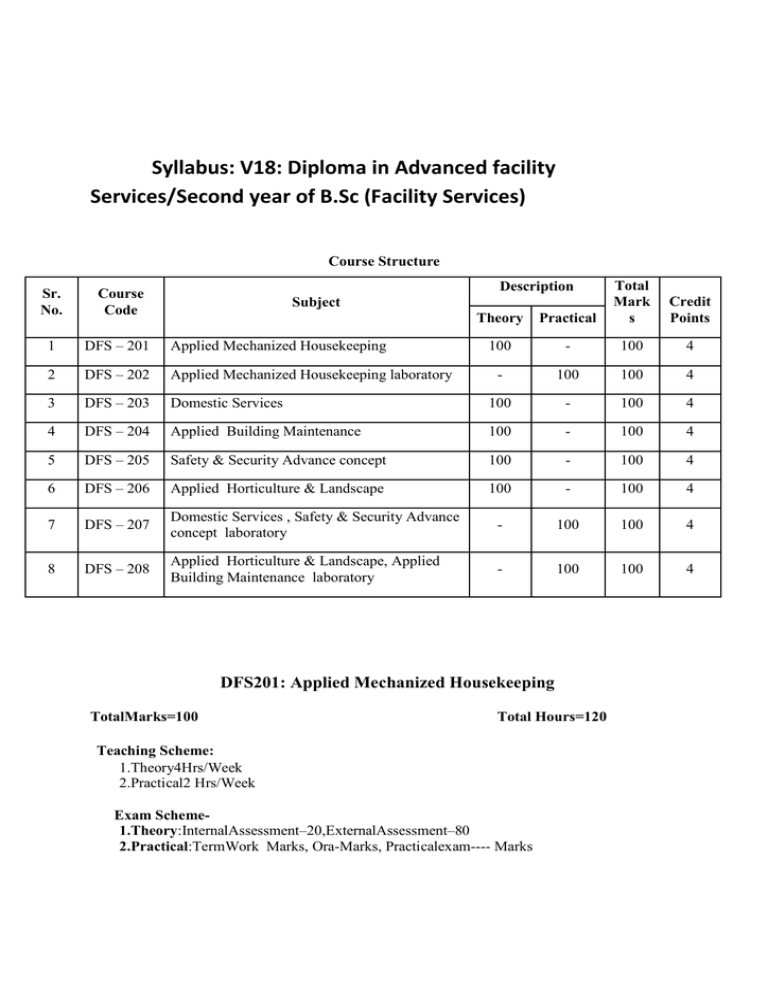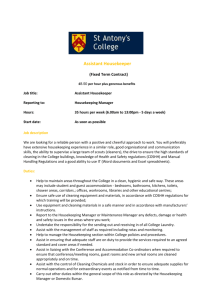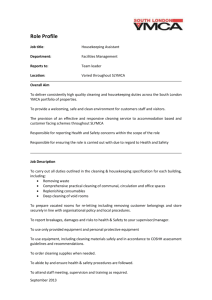Syllabus: V18: Diploma in Advanced facility
advertisement

Syllabus: V18: Diploma in Advanced facility Services/Second year of B.Sc (Facility Services) Course Structure Theory Practical Total Mark s 100 - 100 4 - 100 100 4 Domestic Services 100 - 100 4 DFS – 204 Applied Building Maintenance 100 - 100 4 5 DFS – 205 Safety & Security Advance concept 100 - 100 4 6 DFS – 206 Applied Horticulture & Landscape 100 - 100 4 7 DFS – 207 Domestic Services , Safety & Security Advance concept laboratory - 100 100 4 8 DFS – 208 Applied Horticulture & Landscape, Applied Building Maintenance laboratory - 100 100 4 Description Sr. No. Course Code 1 DFS – 201 Applied Mechanized Housekeeping 2 DFS – 202 Applied Mechanized Housekeeping laboratory 3 DFS – 203 4 Subject DFS201: Applied Mechanized Housekeeping TotalMarks=100 Total Hours=120 Teaching Scheme: 1.Theory4Hrs/Week 2.Practical2 Hrs/Week Exam Scheme1.Theory:InternalAssessment–20,ExternalAssessment–80 2.Practical:TermWork Marks, Ora-Marks, Practicalexam---- Marks Credit Points Unit 1: Housekeeping supervision 1.1.Importance of supervision 1.2. Check list of inspection 1.3. Dirty Dozen Unit 2: Contract Service 2.1. Definition,Concept 2.2. Jobs given by contract by housekeeping. 2.3. Advantages and Disadvantages. 2.4 pricing a contract Unit 3: Housekeeping stores 3.1. Par stock 3.2. Inventory control and stock taking 3.3. Establishing par levels. Unit 4: Staffing in Housekeeping 4.1. Determining staff strength. 4.2. The staffing guide. 4.3. Recruiting, selecting, hiring, orienting & training Unit 5: Budgeting 5.1. Types of budgets. 5.2. Housekeeping expenses. 5.3. Cost control. Unit 6: Pest control 6.1. Types of Pests 6.2. Preventive & Control measures 6.3. Waste Disposal Unit 7: Cleaning routine of Public Areas. 7.1. Weekly, Periodic cleaning carried out. 7.2. Special Cleaning tasks. 7.3. Spring cleaning procedures. 7.4. Types of equipment’s used &care. 7.5. Machinery types use & Care Unit 8 : Purchasing 8.1. Principles of purchasing. 8.2. Stages in purchasing. 8.3. Types of purchasing. Unit 9: Uniforms 9.1. Selection & design of uniforms 9.2. Establishing par levels for uniform. Marks-08 Marks-08 Marks-06 Marks-08 Marks-08 Marks-08 Marks-08 Marks-08 Marks-08 9.3. Store of uniforms. 9.4. Issuing & exchange of uniforms. 9.5. Advantages of providing staff uniforms. Unit 10: Interior designing 10.1. Objectives of interior designing. 10.2. Principles of design . Marks-08 Unit 11: Environment –friendly housekeepingMarks-08 11.1. Choosing eco-friendly supplies . 11.2. Water conservation. 11.3. Energy conservation. 11.4. Waste management & recycling. Unit 12: Changing trends in housekeeping 12.1. Hygiene not cleanliness. 12.2. Training &motivation. 12.3. New scientific techniques 12.4. IT savvy housekeeping. Marks-08 Unit 13: Case study 13.1. Cleaning & maintenance at Mall, Hospital & Industry DFS –202: Applied Mechanized Housekeeping Laboratory TotalMarks=100 1) Draw a neat layout of housekeeping department. 2) Draw a layout of floor pantry. 3) Draw a layout of types of room. ( Single , double , twin ,etc ) 4) Replenishing the supplies of amenities, in the guest room 5) Cleaning & polishing for metal surfaces (Brass,silver,etc) 6) Cleaning & polishing of glass surface 7) Cleaning & polishing of vexene& leather. Marks-08 8) Cleaning of ceramic tices. 9) Cleaning polishing &maintainance of wooden surfaces. 10) Cleaning & polishing of laminated surfaces. 11) Cleaning of wall & floor covering 12) Cleaning of guest room & bathroom. 13)Cleaning of public area(Lobby,Toilet,elevators,stair Case,conferenceroom, banquethall,Soffices,parking lawns patio etc.) 14) Cleaning of paint shop. 15) Cleaning of oven. 16) Cleaning of air intake zone & air supply unit. 18) Cleaning of machines. 19) Case study of cleaning in mall ,industry etc. DFS –203:Domestic Services TotalMarks=100 Total Hours=120 Teaching Scheme: 1.Theory4Hrs/Week 2.Practical2 Hrs/Week Exam Scheme1.Theory:InternalAssessment–20,ExternalAssessment–80 2.Practical:TermWork--- Marks, Oral----Marks, Practicalexam---- Marks Unit 1: Domestic services 1.1. Introduction 1.2. Types of services 1.3. Applications 1.4. Client satisfaction Marks-10 Unit 2: Services Identification Marks-08 2.1. Initial Phase 2.2. Next phase 2.3. Customer class 2.4 Market Survey – Customer Data 2.6. Operation & Procurement Unit 3: House Deep Cleaning 3.1. Introduction 3.2. Scope 3.3. Procedure 3.4. Machinery 3.5. List of tools,Tackles,consumables & Chemicals Marks-08 Unit 4: Painting 4.1. Interior Painting 4.2. Exterior Painting 4.3. Scope 4.4. Procedure 4.5. Material, Tools and Tackles 4.6. Machinery Marks-08 Unit 5: Plumbing Maintenance 5.1 Maintenance 5.2. Development 5.3 Scope of Work 5.4. Procedure 4.5. Material, Tools and Tackles 4.6. Machinery Marks-08 Unit 6: Electrical Maintenance 6.1 Introduction 6.2 Maintenance 6.3. Development 6.4. Scope of Work 6.5. Procedure 6.6. Material, Tools and Tackles 6.7. Machinery Marks-08 Unit 7: Carpentry Work 7.1 Introduction 7.2. Scope of Work 7.3. Procedure 7.4. Material, Tools and Tackles 7.5. Machinery Marks-08 Unit 8: Pest Control 8.1. Introduction 8.2. Scope of Work 8.3. Procedure 8.4. Material, Tools and Tackles 8.5. Machinery Marks-08 Unit 9: Water proofing 9.1. Introduction 9.2. Indoor & Outdoor waterproofing 9.3. Scope of Work 9.4. Procedure 9.5. Material, Tools and Tackles 9.6. Machinery Marks-08 Unit 10:Garden maintenanceand development 10.1. Garden maintenance 10.2. Lawns, Shrubs, Hedging, Trees 10.3. Garden Development 10.4. Procedure 10.5. Material, Tools and Tackles 10.6. Machinery Marks-08 Unit 11: Outdoor Catering Services 11.1. Catering Introduction 11.2. Decoration &Mandap 10.4. Procedure 10.5. Material, Tools and Tackles 10.6. Machinery Marks-08 Unit 12: Strategies in Services 12.1. Marketing 12.2. Operational 12.3. Development 12.4. Feedback Marks-08 DFS –204:Applied Building Maintenance TotalMarks=100 Teaching Scheme: 1.Theory4Hrs/Week 2.Practical2 Hrs/Week Total Hours=120 Exam Scheme1.Theory:InternalAssessment–20,ExternalAssessment–80 2.Practical:TermWork--- Marks, Oral----Marks, Practicalexam---- Marks Unit 1 :IntroductionMarks-08 TypesofTrades, Utilities, Objectives, Safety Issues, Maintenance work, Water Supply & Sewage System,Water Supply & Sewage System,Ventilation Unit 2 :Concept of Safety Marks-10 Need, Safety Provisions in the Factory Act, Laws related to the Industrial Safety, Measurement Of Safety Performance, Safety Audit, Problem Areas In building maintenance Safety, Job site Safety assessment- Safety Meetings-Safety Incentives, Safety Organization –Safety Policy, Safety Record Keeping, Safety Culture-Safe Workers-Safety and First Line Supervisors-Safety and Middle Managers-Top Management Practices, Company Activities and Safety-Safety Personnel-Sub contractual obligation, Project Coordination and Safety Procedure Unit 3 : Maintenance Work Tenders Marks-08 Prequalification, Bidding, Accepting, Evaluation of Tender from Technical, Contractual and commercial points of view-contract formation and interpretation-Potential contractual problems-World Bank Procedures and Guidelines Unit 4: Modern Maintenance Concept Marks-10 Definitions, objectives , Phases of Maintenance, Repair and Rehabilitation, Common Defects In Buildings related to plumbing, electrical fitting, construction, Measures To Prevent And Control The Same- Building maintenance Failures – Causes And Effects- -Preventive Measures Inspection, Assessment Procedure For Evaluating Damaged Structure -Causes of Deterioration Testing Techniques- Non Destructive Testing Methods. Unit 5:Water Supply & Sewage SystemMarks-08 Water quality, Purification and treatment- water supply systems-distribution systems in small towns -types of pipes used- laying jointing, testing-testing for water tightness plumbing system for building-internal supply in buildings- municipal bye laws and regulations - Rain Water Harvesting - Sanitation in buildings- -pipe systems- storm water drainage from buildings -septic and sewage treatment plant - collection, conveyance and disposal of town refuse systems. Unit 6: Electrical SystemMarks-08 Types of wires , wiring systems and their choice -planning electrical wiring for building -main and distribution boards -transformers and switch gears -modern theory of light andcolour synthesis of light -luminous flux -candela- lighting design-design for modern lighting. Industrial wiring System, Earthing site Unit 7:VentilationMarks-08 Ventilation and its importance-natural and artificial systems-Window type and packaged airconditioners-chilled water plant -fan coil systems-water piping -cooling load –air conditioning systems for different types of buildings -protection against fire to be caused by A.C. systems. Unit 8:Safety Against fire in buildingsMarks-10 Safety-Ability of systems to protect fire-Preventive systems-Fire escape system design-Planning for pollution free construction environmental-Hazard free Construction execution safety regulations-NBC-planning considerations in buildings like Non-combustible materials, construction, staircases and A.C. systems-heat and smoke detectors-dry and wet risers-Automatic sprinklers - Capacity determination of OHT and UGT for firefighting needs. Unit 9:Labour and Equipment UtilizationMarks-08 Labour Productivity-Factors Affecting Job-Site Productivity-Labor Relations in constructionProblems in collective bargaining-maintenance Equipment-Choice of Equipment and Standard production Rates-maintenance Processes Queues and Resource Bottlenecks Unit 10: Disaster PlanningMarks-08 Possibilities on site, Disaster Response Personnel and duties, Community Mitigation Goals, PreDisaster Mitigation Plan, Personnel Training, Volunteer Assistance, Hazardous Materials, Ways of storing and safely handling hazardous materials, Coping with Exposure to Hazardous Materials Unit 11: Reuse & RecycleMarks-08 Waste as a Resource, Resource Economics, Disposable Materials, Recovery, Recycling, Collection, Processing, Governmental Role in Waste Management, Potential for Reuse. Waste Analysis: Sampling, Composition, Categorization Unit 12: Case Studies based on Construction, plumbing, electrician, air conditionerMarks-06 DFS –205: Safety & Security Advance concept TotalMarks=100 Teaching Scheme: Total Hours=120 1.Theory4Hrs/Week 2.Practical2 Hrs/Week Exam Scheme1.Theory:InternalAssessment–20,ExternalAssessment–80 2.Practical:TermWork--- Marks, Oral----Marks, Practicalexam---- Marks Unit 1:OHASAS 1800 (occupational health and safety assessment safety) system Marks-08 1.1 Introduction 1.2 Occupational health and safety assessment safety Unit 2: Security risk management 2.1 Introduction 2.2 Types of security threats 2.3 External security threats 2.4 Internal security threats Marks-08 Unit 3:Risk management 3.1 Principles of risk management 3.2 Identification 3.3 Process 3.4 Assessment Marks-08 Unit 4: Self-defense 4.1 Self defense education 4.2 Legal Aspect 4.3Criminology Marks-08 Unit 5: Conflict management 5.1 Nature of conflict 5.2 role of security department during conflict Marks-06 Unit 6: Emergency Management 6.1 Introduction 6.2. Emergency Service’s 6.3. Precaution 6.4 disaster Management Marks-08 Unit 7: Safety Audit 7.1 Introduction 7.2. Audit sheet 7.3 Understanding the concept 7.4 Report Generation 7.5 Report evaluation Marks-10 Unit 8: Strengthening safety and security 8.1 Safety and security 8.2A range of measures 8.3 Triggers 8.4 Supporting factors 8.5Arguments against organizational changes 8.6 Where are the change-agents? Marks-10 Unit 9: Implementation 9.1 Operational reinforcements 9.2 Risk assessments 9.3 Quality control 9.4 The management of some specific threats 9.5 Improving personnel management 9.6Competence: knowledge and skill development Marks-08 Unit 10: Managing change 10.1Less-significant factors 10.2 Factors with variable influences 10.3 Significant factors 10.4 A management plan for change Marks-10 Unit 11: Important factors 11.1 Importance of green cross 11.2 Importance of heinrich pyramid 11.3 Conduct safety training per week 11.4 importance job safety analysis 11.5 hazard identification risk assessment Marks-10 Unit 12: Case study :Moc Drill – Industry Marks-06 DFS –206: Applied Horticulture& Landscape TotalMarks=100 Teaching Scheme: Total Hours=120 1.Theory4Hrs/Week 2.Practical2 Hrs/Week Exam Scheme1.Theory:InternalAssessment–20,ExternalAssessment–80 2.Practical:TermWork--- Marks, Oral----Marks, Practicalexam---- Marks Unit 1: Scope & importance of landscaping Marks-6 Unit 2: Important garden features 2.1 Paved areas 2.2 Garden electrification 2.3 Water feature 2.4 Pergola 2.5 Seating 2.6 Play area 2.7 Lawn Marks-8 Unit 3: Advanced gardening practices 3.1 Vertical garden 3.2 Kitchen garden 3.3 Glass garden & dish garden 3.4 Terrace garden Marks-6 Unit 4: Soil fertility management 4.1 Soil Management Practices 4.2 Manures 4.3 Manuring and improvement of Soil Fertility 4.4 Fertilizers 4.5 Micronutrients 4.6 Application of Fertilizer 4.7 Fertilizer Dose 4.8 Time of Manure and Fertilizer Application 4.9 Integrated Nutrient Management (INM) Marks-10 Unit 5: Water management 5.1 Indispensable Water 5.2 Methods of Irrigation 5.2.1 Check – basin method 5.2.2 Furrow method Marks-10 5.2.3 Ring – basin system 5.2.4 Basin system 5.2.5 Flood system 5.2.6 Pitcher system 5.2.7 Funnel system 5.2.8 Bubbler system 5.2.9 Sprinkler system 5.2.10 Drip irrigation system 5.2.10.1 Advantages of drip irrigation 5.3 Scheduling Irrigation 5.4 Measurement of Irrigation Water 5.5 Quality of Irrigation Water 5.6 Critical Period for Irrigation Unit 6: Nutrition of plants by fertilizers 6.1 Role of Nutrients 6.2 Deficiency of Nutrients 6.3 Indication of Nutrients Deficiency 6.4 Biofertilizers Marks-6 Unit 7: Weed management 7.1 Losses Caused by Weed 7.2 Weed Control Methods 7.2.1 Preventive Methods 7.2.2 Curative Methods, 7.3 Control of Weeds 7.3.1 Mechanical / Physical methods 7.3.2 Cultural methods 7.3.3 Biological methods 7.3.4 Chemical methods 7.4 Commonly Growing Weeds 7.5 Types of Herbicides 7.5.1 Selective herbicides 7.5.2 Non-selective herbicides 7.6 Action of Herbicides 7.6.1 Inhibition of germination 7.6.2 Inhibition of photosynthesis 7.6.3 Inhibition of respiration 7.6.4 Inhibition of synthesis 7.6.5 Hindrance in activities Marks-12 7.7 Calculation of Herbicides Unit 8: Management of Pest & Diseases 8.1 Pest Management 8.1.1 Biological control 8.1.2 Mechanical control 8.1.3 Physical control 8.1.4 Cultural control 8.1.5 Chemical control 8.1.5.1 Inorganic insecticides 8.1.5.2 Organic insecticides 8.2 Commonly occurring important pests 8.3 Uses of Some Common Insecticides 8.4 Disease Management 8.4.1 Escape from pathogen 8.4.2 Preventing entry of inoculums 8.4.3 Eradication 8.4.4 Protection 8.4.5 Reaction of host crop 8.4.6 Prophylactic measures 8.4.7 Biological control 8.4.8 Chemical control 8.4.8.1 Inorganic / organic fungicides 8.4.8.2 Systemic fungicides 8.5 Useful Formulations 8.5.1 Bordeaux mixture 8.5.2 Bordeaux paste 8.5.3 Bordeaux paint Marks-12 Unit 9: Green house & Tissue culture practices 9.1 Types of green houses 9.1.1 Covering material 9.1.2 Environmental control 9.1.3 Shape 9.2 Working of a green house 9.3 Designing a green house 9.4 Composition of a green house 9.5 Construction of a green house 9.6 Requirements for planting in green houses 9.7 Introduction of Tissue culture 9.8 Advantages of propagation through tissue culture 9.9 Culture medium for tissue culture Marks-10 9.10 Composition of tissue culture media Unit 10: Applied tools & implements Marks-6 Unit 11: Landscape designs 11.1 Residential garden 11.2 Multistoried building garden 11.3 Indoor landscaping of a hall 11.4 Institutional garden 11.5 Restaurant garden Marks-8 Unit 12: Cost estimation & project planning Marks-6 DFS –207: Domestic Services, Safety & Security Advance concept laboratory TotalMarks=100 Section 1: Domestic Services 1. 2. 3. 4. 5. 6. 7. 8. Study & demonstration of Car washing Study & demonstration of Painting To study House deep&Water Tank cleaning Interior Decoration Water proofing Study & demonstration of Plumbing maintenance Electrical maintenance To study Civil repair Section 2: Safety & Security 1. 2. 3. 4. 5. To Study and understand safety tools. Installation of DVR System. CCTV Camera installation To study and understand security tools. To create audit report for safety. 6. To implement safety & security mechanism for organization. 7. To study electrical safety. DFS –208: Applied Horticulture& Landscape, Applied Building Maintenance laboratory Section 1: Applied Horticulture & Landscape 1. 2. 3. 4. 5. 6. 7. 8. To study and understand Soil. To study basic graphics tools. To understand the client requirements and convert the requirements into graphics design. To study and understand different types of fertilizers. Design and implementation of vertical garden. Design and implementation of kitchen garden. Design and implementation of glass garden & Dish Garden. To study different methods of Irrigation -I Check – basin method Furrow method Ring – basin system Basin system Flood system 9. To study different methods of Irrigation-II Pitcher system Funnel system Bubbler system Sprinkler system Drip irrigation system 10. To study different nutrition’s required for plant. 11. To study different pest & Diseases. Section 2: Applied Building Maintenance laboratory 1. 2. 3. 4. 5. To study and understand safety tools for building maintenance. Requirement of brick wall 10, 20 & 30 cm. All types of bonds. Practice of stone masonry & ashlars and rubble masonry. Repair and finish cracks in old brick work and stone work. How to pointing and plastering. Practice of cement concrete and line concrete work. To make RCC lintel and arch of any span after making arrangement of centering. 6. Construction of floors of different types. 7. Repairing of defective work. Repairing of crack in various types of roofs to stop leakage. 8. Vitrified and glazed tiles work, RCC materials, form work, bars & constructive materials used. 9. Painting of wood/steel work. Whitewashing / distempering and colour washing of building. Construction of false ceiling and wall papering. 10. Replacement broken glass of window, ventilator etc. Varnishing and polishing. 11. Types of motor and pumps, selecting proper pump and motor. 12. Checking parts dead weight and cables of lift. Oiling, greasing the parts and auto doors etc.






